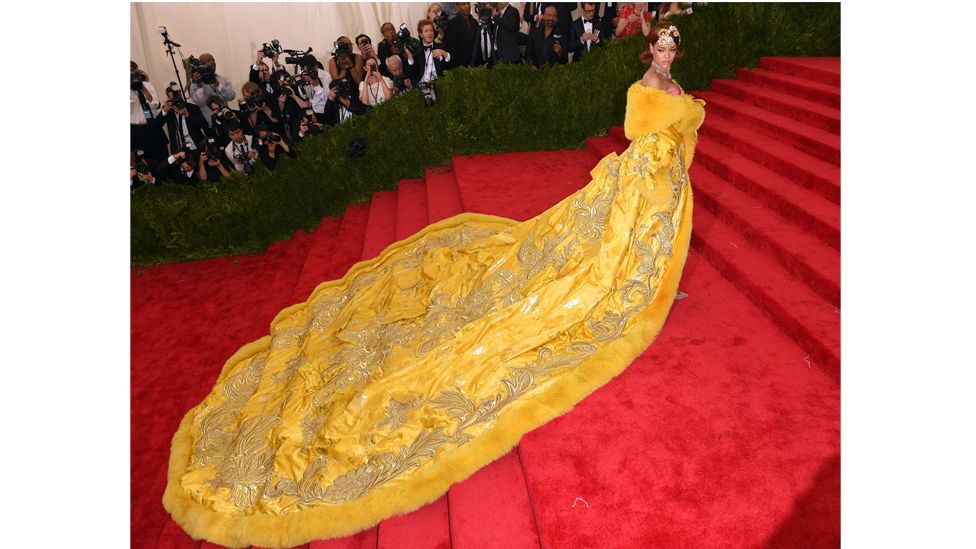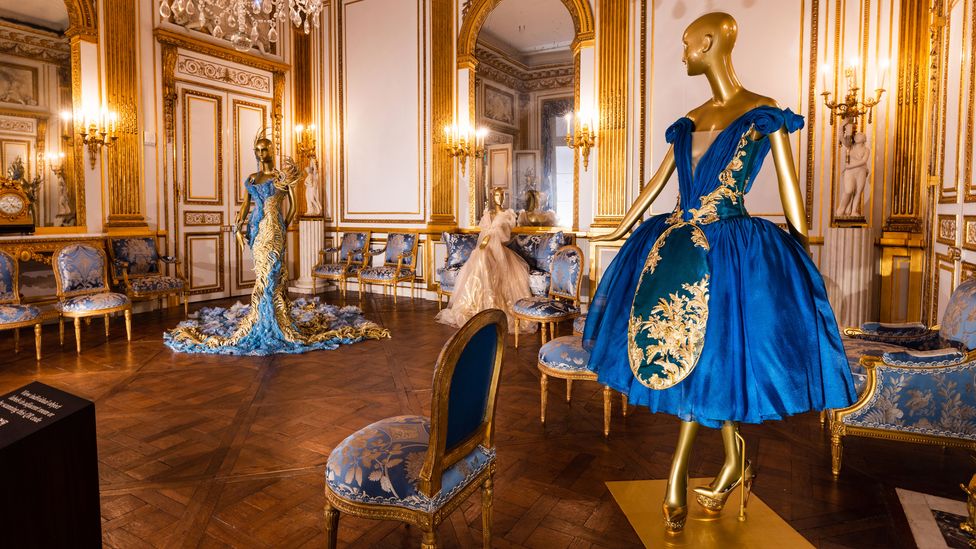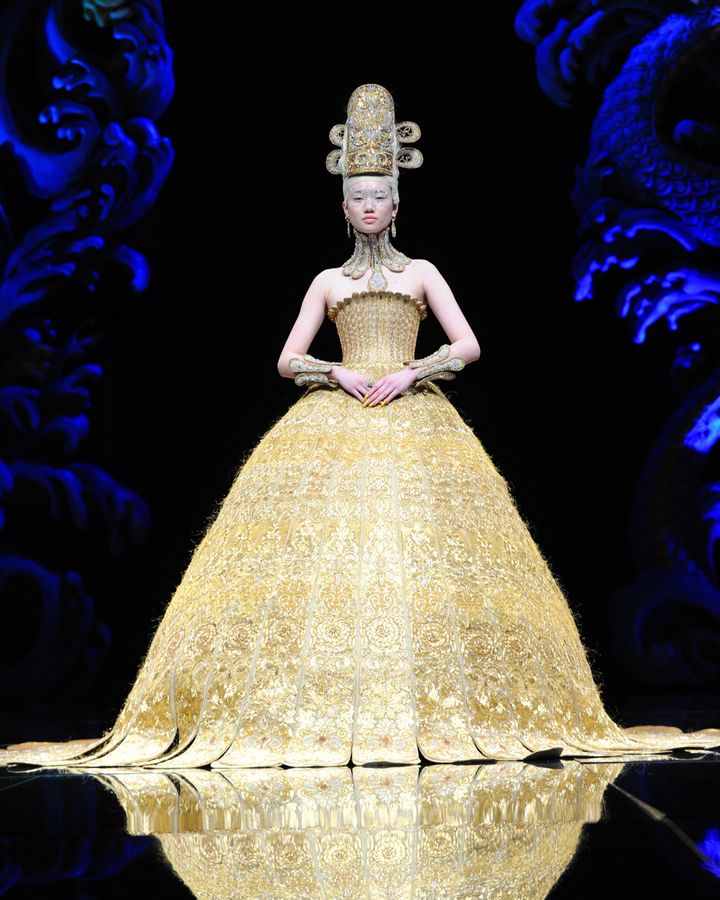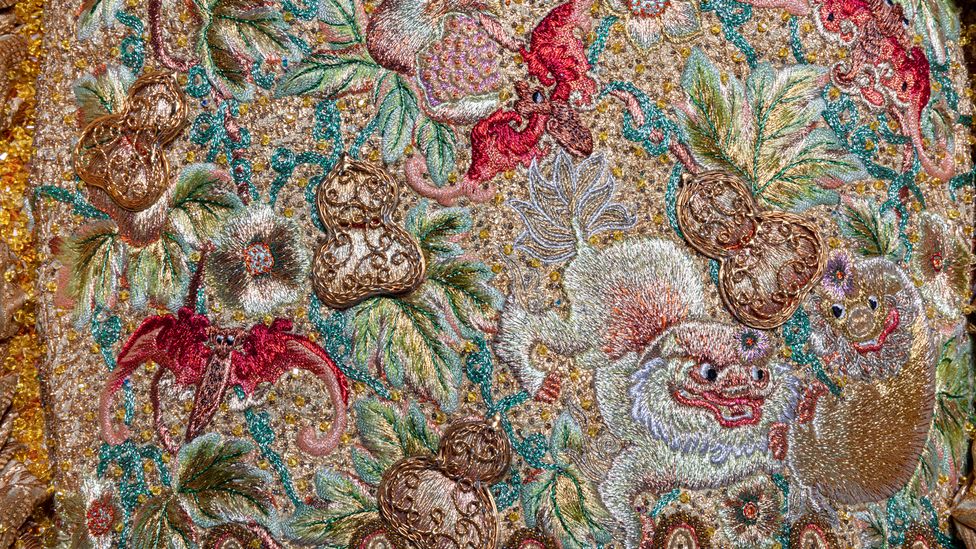The world’s most striking dresses

It’s almost a cliché to refer to certain fashion designs as works of art but when it comes to the Chinese couturier Guo Pei, the comparison is richly deserved. Her extraordinary creations, which can be seen in the Guo Pei: Couture Fantasy exhibition at the Legion of Honor museum in San Francisco, are inspired by everything from Chinese Imperial history to European court dress and cathedral architecture. Her fantastical gowns and accessories blur the boundaries between fashion, art and sculpture. From futuristic ensembles to porcelain-inspired robes with gravity defying pleats, her creations are a world apart from other designers.
More like this:
– The ancient enigma that resonates now
– Inside the ethical beauty boom
– How to make your clothes last longer
“She’s not constrained by an immediate sensibility of what is in or out,” says Thomas P Campbell, director and CEO of the Fine Arts Museums of San Francisco. “She comes from a totally different direction, and has forged her own path that comes out of her own lived experiences and fecund imagination that seems to bring disparate components together and find connections that are exceptional. I can’t think of anyone like her, quite frankly, in the way she synthesises so broadly.”

Guo dressed Rihanna for the Met Ball in 2015 in a spectacular yellow cape with long train (Credit: Getty Images)
Campbell first came across Guo at the China: Through the Looking Glass exhibition at the Metropolitan Museum of Art in New York in 2015, which included her spectacular Da Jing gown. The entire surface of its bodice and monumental bell-shaped skirt is lavishly embroidered in gold and silver thread, a process that took two years to complete and cost a staggering $1m. That same year, Guo came to international attention when she dressed Rihanna for the Met Ball in a richly embellished lemon-yellow cape, trailing 14ft (4.3m) long and weighing an astonishing 55lbs (25kg). The West may have suddenly woken up to her phenomenal talent, but Guo had been honing her unique aesthetic for decades prior to that.
Guo’s extraordinarily creative mind developed in less-than-auspicious surroundings. Born in 1967 at the start of Mao’s Cultural Revolution, she had an austere childhood in the household of her platoon-leader father. Solace came in the form of her maternal grandmother who was raised in an elite family during the twilight days of the last Imperial era, the Qing Dynasty. Although she had been forced to destroy all her possessions including clothing, jewellery and photographs, at night she would regale the young Guo with descriptions of exquisite garments, sowing seeds in her fertile imagination. “I thought the clothes looked better because I couldn’t see them, so a wish was planted in my heart. It made me believe I could create even more beautiful clothes,” Guo tells BBC Culture.
When Deng Xiaoping came to power in 1978, two years after Mao’s death, his sweeping reforms enabled Guo to attend one of the newly established government-operated fashion programmes. However, neither the students nor teachers had much knowledge of global fashion trends, leaving Guo to find inspiration in films such as Gone with the Wind and historical Western novels. At a loss as to how to help her create the garments of her dreams, her tutors sent her to the theatre for guidance. One of the few art forms that was allowed to continue during the Cultural Revolution, thanks largely to the fact that Mao’s wife was an actress, the theatre was an environment where clothing designers could still express their artistry when everything outside was dour and grey. The sense of spectacle would have a profound effect on Guo, both on her clothing designs and the theatrical nature of her catwalk presentations.

Guo’s work is the subject of a new exhibition at the Legion of Honor, San Francisco (Credit: Guo Pei/ Legion of Honor/ Fine Arts Museum, San Francisco)
“When I was working on my graduation design, I specifically wanted to make a very large skirt, like in western movies, but I had no idea how the inside of the skirt would need to be made,” Guo tells BBC Culture. “I went to the theatre and asked the costumers if they could help me. I was very surprised when they took me backstage and showed me a pannier made of bamboo and layers of petticoats that were hidden inside a skirt. It helped me create what was probably the largest dress in the Chinese fashion designer industry. The theatre experience was the beginning of me making big dresses.”
Graduating with the highest grade in her class, Guo went on to a successful career in the nascent Chinese fashion industry. However, despite her achievements, she felt creatively thwarted as she was unable to create the magnificent dresses she wanted. It wasn’t until she established her own design house, Rose Studio, in 1997, that she could truly begin to unleash her creative desires. With no Chinese precedents to turn to as an example, Guo created a fashion house in her own image, which just like her graduation collection, paid little heed to the conventional ways of doing things.
“It was outside of the Parisian system,” says Jill D’Alessandro, curator of the exhibition. “She didn’t even know how a couture house was formulated. The approach was closer, I feel, to an art-making approach of problem-solving. She said: ‘I have people who studied fashion design making jewellery and I have people who studied furniture design making shoes’. In Paris you might go to a specific atelier who only does feather work or embroidery.”
Awe inspiring
Guo’s aesthetic inspiration expanded when travel to the West became easier for Chinese nationals in the early years of the 21st Century, and she was able to view historic examples of fashion, textiles and embroideries in European museums. The Napoleonic uniforms she saw in the Musée de l’Armée in Paris, which to her symbolised the cycle of human life, came to influence her breakthrough 2006 Samsara presentation, which she considers to be her first true haute couture collection. Da Jing was the awe-inspiring finale to the show.

The awe-inspiring Da Jing gown was the finale of Guo’s first haute couture show (Credit: Getty Images)
“Da Jing is like the sun to me, it means the beginning of haute couture in my heart, and it meant a breakthrough for me, a moment when I found my direction in my 20-year career as a designer. Da Jing represents the start of my artistic creation,” says Guo. Her designs since then frequently defy categorisation. The full, wide skirts that she so adores come adorned with trailing golden botanicals or layers of tulle that part like curtains to reveal a theatrical scene within. Shoes are made of toweringly impractical clear resin with floral embroidery climbing their enormous soles or pleated silk across the foot.
“She doesn’t have any constraints but the reason she’s able to do that is that she’s got two bodies of work – bespoke pieces for her clientele which are made to measure in the true couture sense, but then the pieces we’re showing in the museum and the pieces she shows on the runway are pieces that hover between fashion and sculpture and theatre, and that’s where she lets her imagination run wild. They occupy a space outside fashion in the traditional sense of the word,” explains D’Alessandro.
Her designs are particularly renowned for their lavish embroidery, although when she started out it was virtually impossible to find the artisans she required. The teaching of embroidery had been abandoned in the 1930s, and hardly anyone embroidered during the Cultural Revolution, when all clothing was plain and austere. Guo had to travel to rural areas around Beijing in order to find villagers with the necessary skills, and even then their work was quite basic. Gradually she was able to hone their skills via historic examples she brought back from her travels.

Intricate embroidery incorporates motifs drawn from both Chinese Imperial Court and European Baroque traditions (Credit: Guo Pei/ Legion of Honor/ Fine Arts Museum, San Francisco)
“I shared with them the embroidery from museums and other places around the world, and I also bought many embroidery books to communicate with them and imagine how the embroideries were completed. The style of embroidery we have developed today is not entirely traditional Chinese, but inspired by various countries and ethnicities and incorporating their characteristics,” says Guo.
This magpie approach plays beautifully into her unique aesthetic. As Campbell puts it: “While one dress might incorporate motifs that are drawn from a Chinese Imperial Court tradition, they might be embodied in a dress whose shape is inspired by a kind of European Baroque gown. She transcends the East/ West dialogue.”
Following on from the attention she garnered at the Met in 2015, Guo was invited to be a guest member of the prestigious Chambre Syndicale de la Couture in Paris, making her only the second Chinese-born-and-educated designer to be invited in its 147-year history. Between 2016 and 2020, she showcased 10 collections at Paris Haute Couture week, revealing the full theatricality of her designs and catwalk presentations to a truly global audience.
“The interplay between theatre and fashion is deep-rooted in Chinese sartorial practices,” explains D’Alessandro. “When she’s doing her runway presentations, she’s presenting them like theatre; she has a narrative, there are characters, and she collaborates with theatre directors to develop her shows.”

Towering, futuristic shoes of clear resin by Guo feature floral embroidery (Credit: Guo Pei/ Legion of Honor/ Fine Arts Museum, San Francisco)
The pandemic may have put a stop to her Paris presentations, but Guo is keen to return. “Paris, for me, is a bigger stage, where people from all over the world can see my works. For me the purpose of creating works is to share them, with the hope that people from different cultural backgrounds will come together in the exchange and spread of culture,” says Guo.
Until then, fans of her work will have the opportunity to see her creations in what is perhaps their natural setting, a museum, where the phenomenal craftsmanship and detail can be viewed up close.
Guo Pei: Couture Fantasy is at the Legion of Honor Museum, San Francisco, until 5 September 2022.
If you would like to comment on this story or anything else you have seen on BBC Culture, head over to our Facebook page or message us on Twitter.
And if you liked this story, sign up for the weekly bbc.com features newsletter, called The Essential List. A handpicked selection of stories from BBC Future, Culture, Worklife and Travel, delivered to your inbox every Friday.








